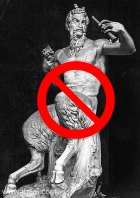Updated: 2021.03.20
עעע
 וַיֵּצֵ֤א הָרִאשׁוֹן֙ אַדְמוֹנִ֔י כֻּלּ֖וֹ כְּאַדֶּ֣רֶת שֵׂעָ֑ר וַיִּקְרְא֥וּ שְׁמ֖וֹ עֵשָֽׂו׃
וַיֵּצֵ֤א הָרִאשׁוֹן֙ אַדְמוֹנִ֔י כֻּלּ֖וֹ כְּאַדֶּ֣רֶת שֵׂעָ֑ר וַיִּקְרְא֥וּ שְׁמ֖וֹ עֵשָֽׂו׃
 250x364.jpg) |
 Ei•sâuꞋ-Εd•ōmꞋ and capital, Mt. Sei•irꞋ (בָּצְרָה, corrupted to "Bozrah") Ei•sâuꞋ-Εd•ōmꞋ and capital, Mt. Sei•irꞋ (בָּצְרָה, corrupted to "Bozrah") |
 0350x263.jpg) |
 Har Sei•irꞋ – ruins of ancient capital, בָּצְרָה (corrupted to "Bozrah") Har Sei•irꞋ – ruins of ancient capital, בָּצְרָה (corrupted to "Bozrah") |
 |
Hellenist Greco-Roman Pan |
Because Ya•a•qovꞋ declared to his mother, RiꞋvᵊq•âh, that
עֵשָׂו
אָחִי
אִישׁ
שָׂעִר
(bᵊ-Reish•itꞋ 27.11), the name שָׂעִיר – goat-like or satyr-like – has also been associated with עֵשָׂו-אֱדוֹם. As a result, עֵשָׂו-אֱדוֹם has been associated with the Greek satyr idol Pan.
That עֵשָׂו-אֱדוֹם-שָׂעִיר settled and conquered the land of the Sᵊir•imꞋ, הַר-שֵׂעִיר (capital of Ë•dōmꞋ at Bâ•tzᵊr•âhꞋ), firmly corroborated the association. This association with the Greek satyr idol Pan, in turn, shares a connection with Sâ•tânꞋ. This resulted in אֱדוֹם becoming the symbol of Sâ•tânꞋ – and Hellenist Greek – Christian – Rome! This connection, in turn, further connected (see Sâ•tânꞋ) with the "Great Whore of Babylon, the Mesopotamian idol Ishtar (morphed into Greek Aphrodite, morphed into Roman Venus, morphed into Latin Lucifer).
 © 1996-present by Paqid Yirmeyahu Ben-David,
© 1996-present by Paqid Yirmeyahu Ben-David,
Google+ registered author & publisher


![]()
![]() וַיֵּצֵ֤א הָרִאשׁוֹן֙ אַדְמוֹנִ֔י כֻּלּ֖וֹ כְּאַדֶּ֣רֶת שֵׂעָ֑ר וַיִּקְרְא֥וּ שְׁמ֖וֹ עֵשָֽׂו׃
וַיֵּצֵ֤א הָרִאשׁוֹן֙ אַדְמוֹנִ֔י כֻּלּ֖וֹ כְּאַדֶּ֣רֶת שֵׂעָ֑ר וַיִּקְרְא֥וּ שְׁמ֖וֹ עֵשָֽׂו׃ 250x364.jpg)
 0350x263.jpg)


